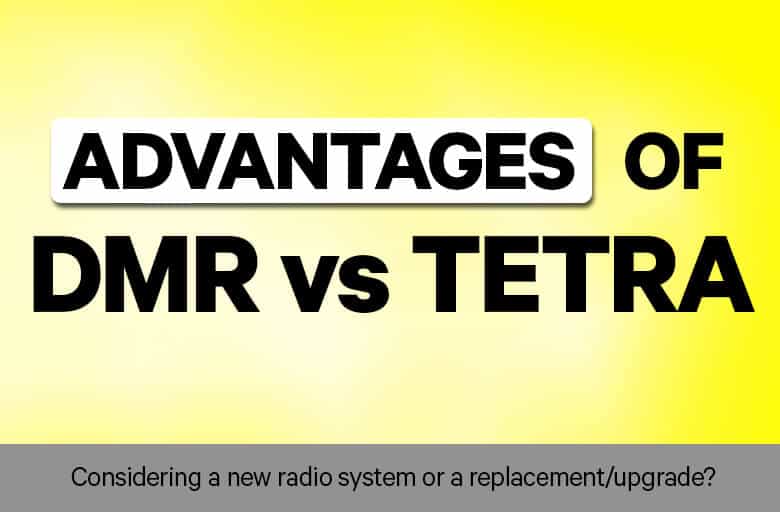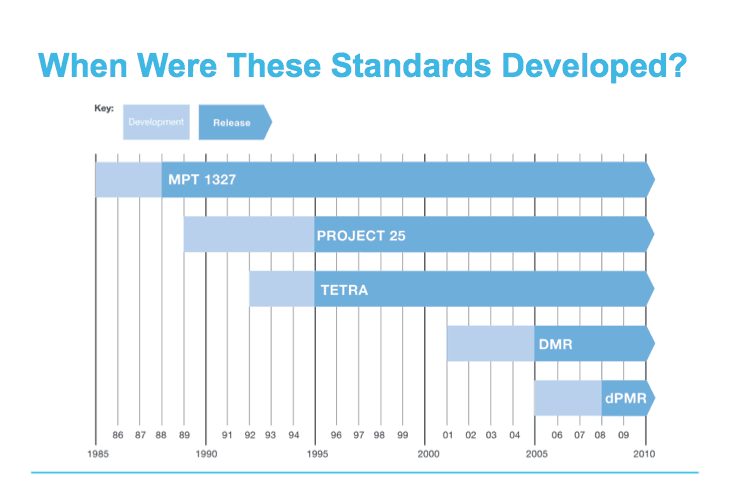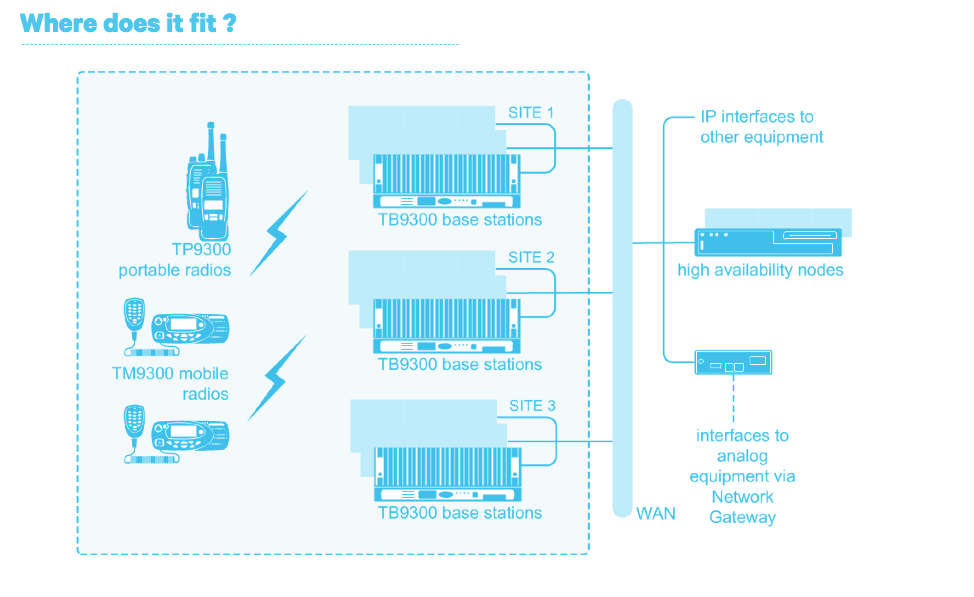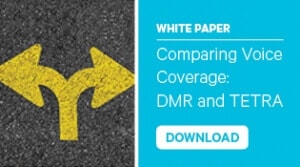 If you are considering a new radio system or a replacement/upgrade of your existing system, choosing the right technology is of prime importance. The decision to use a particular technology should always be based on best fit to achieve the project’s objectives.
If you are considering a new radio system or a replacement/upgrade of your existing system, choosing the right technology is of prime importance. The decision to use a particular technology should always be based on best fit to achieve the project’s objectives.
In the article below, we have aimed at comparing the relative advantages and disadvantages of DMR and TETRA along several factors including coverage, frequency bands, fallback to analog and the ease and cost of migration.
What is TETRA?
- Is an ETSI standard digital radio solution that is more like a cellular telephone system than other LMR standards.
- Standards (EN 300 392) were published in 1995 – the same time as P25 phase 1 was published in the USA.
- Operates in 25kHz channels and uses 4 slot TDMA to achieve 6.25kHz equivalence (1 communication path per 6.25kHz of spectrum)
- Only includes trunked operation.
- Primary market is Europe. It is starting to appear in the USA and Oceania.
What is DMR?
- DMR is an ETSI standard, low complexity professional digital radio solution designed to replace analog FM radio that is cost effective.
- Standards (ETSI TS102 361) were published in 2005. There are 3 ‘Tiers’ specified – Tier II and Tier III are for professional users.
- Operates in 12.5kHz channels and uses 2 slot TDMA (Time Division Multiple Access) to achieve 6.25kHz equivalence. Tier II is conventional, Tier III is trunked.
- Offers an easy path to migrate analog FM LMR users to 6.25kHz digital radio technology.
- Fast gaining traction in the Americas and Oceania as a lower cost alternative to P25.
 Key Differentiators
Key Differentiators
Coverage
- DMR has the same coverage as analog FM. Users of Analog FM upgrading to DMR can re-use all the same sites.
- In theory – to cover the same area would need 7 TETRA sites for every 2 DMR sites, i.e. 2 DMR sites cover roughly the same area as 7 TETRA sites.
- Practical experience from real life TETRA Deployments shows TETRA coverage is worse than this. For more information you can read the DMR or TETRA technical comparison of coverage article
Choice of Frequency Bands
- DMR systems can be deployed in any band above 136MHz used by analog FM LMR (VHF, UHF or 700/800MHz). Analog FM users upgrading to DMR can re-use their existing channels.
- TETRA is limited to parts of the spectrum where 25kHz channels are licensed. In Europe this is 380-430MHz. 800MHz is available in USA, Australia and New Zealand.
- Analog FM users migrating to TETRA will probably need to license new channels.
Fallback to Analog FM
- Modern DMR terminals have an analog FM fall back mode. They support analog narrowband FM mode as well as the new digital mode. This means that networks can be upgraded in stages, and that the fleet of radios can be upgraded as radios reach the end of their useful life. Users with new digital radios can talk with those on analog FM radios, using analog channels in the same band.
- TETRA has no analog FM fall back mode.
Ease / cost of Migration from Analog FM
- An analog FM user migrating to TETRA will need completely new infrastructure, additional sites, and probably need to license new channels.
- An FM user migrating to DMR can re-use existing infrastructure, existing sites, and existing frequencies. It is a very simple migration (ease of migration is a fundamental of the DMR standard).
Important Takeaways
- DMR is designed for high volumes of radio traffic over wide coverage areas. For example, it is an excellent fit for low cost, mission critical applications. GridLink and transport networks (many data messages coming from throughout a large area) are perfect applications for DMR.
- TETRA is designed for high volumes of radio traffic over smaller coverage areas within dense urban environments.
- There are references to number of TETRA systems vs number of DMR systems in Europe, it is misleading. It is only heavily weighted in favor of TETRA because it has existed much longer. This is not a relevant statistic when considering which technology is best for the job.

7 key questions to think about
- Do you have an existing analog LMR radio system you are looking to replace? If so, what type of system is it (conventional, trunked eg: MPT1327)?
- How many sites does your system use? How far apart are they? Do you have good coverage now, or are there dead spots you need to fill?
- What frequencies / channels do you have licensed? Do you want to re-use these?
- How many users will there be on the system? How are they distributed throughout the covered are? Is the main use voice or data? If voice – how long is a typical conversation? If data, how long is a typical message?
- Is system reliability and flexibility important to you?
- DMR Tier 3 is the natural replacement for analog MPT 1327 solutions. How does that change your organization?
- Do you maintain your own radio system at present? Would you consider it being managed?
Transitioning from analog to digital can raise plenty of questions. If these questions were relevant to you and you need help, then please contact us or leave a comment below and we will get in touch with you.
 Download the free DMR vs TETRA whitepaper to learn more.
Download the free DMR vs TETRA whitepaper to learn more.
To get updates as our posts get published, subscribe via email below:
Email Address




This radio is amazing. I take advantage of it for everyday use and do not know what may be done to boost it. Profitable. Easy to program yourself via computer or Hsiang keyboard. The battery life is amazing. Super fast charging. and also the range works better than my Kenwood handheld. and that I love having the ability to use one handheld rather than two.
Comparison between DMR Tier III and Tetra is clear.
But what about Tier II and III? Generally what are the pros and cons of conventional and trunked communication
Thnx in advance
Hi George, thanks for the question. You can take a look at our DMR Tier II vs DMR Tier III video here: https://www.youtube.com/watch?v=0GpoPe6ePg0
Can I have the difference between DMR Tier III and P 25 What are the main advantages of DMR Tier III vis a vis P 25
Hi there, you can learn more about DMR Tier III and P25 via our video tutorials available here: http://www.taitradioacademy.com/courses/
Hi Isidor, for DMR and P25, a base station transmitter will be 50W or 100W, a mobile transmitter 25W up to 50W and for a hand portable 3W to 5W.
TETRA transmitters are more complicated transmitters in order to preserve the modulation (the information conveyed by the transmission), so their transmit powers are usually less than P25 or DMR.
What are the rough transmit powers of TETRA, P25 and DMR?
I would also like to see a copy of your engineers report please comparing TETRA and DMR coverage.
Hi Robin – Here’s a white paper you can download comparing DMR and Tetra coverage: http://go.taitradio.com/comparing-voice-coverage-dmr-and-tetra.html
I’d like to see that report as well. It would be great to be better informed on the differences in coverage!
Hi Ken – Here’s a white paper you can download comparing DMR and Tetra coverage: http://go.taitradio.com/comparing-voice-coverage-dmr-and-tetra.html
In theory – to cover the same area would need 7 TETRA sites for every 2 DMR sites, i.e. 2 DMR sites cover roughly the same area as 7 TETRA sites.
Can you provide the Theory behind this Statement – I am intrigued to see this explained!!!
Thanks Jimmy, I have just sent you an email to see if you would like a copy of a report from one of our engineers. I look forward to your reply.